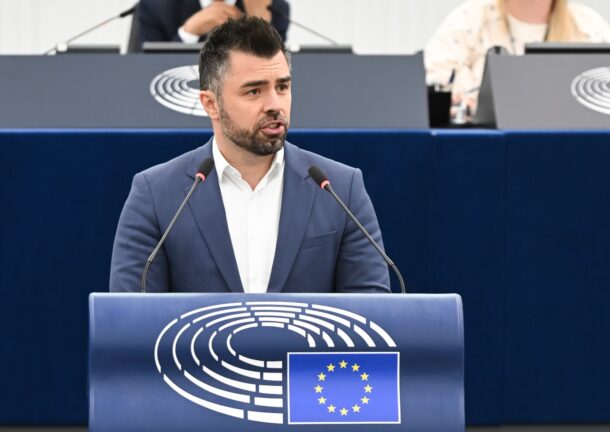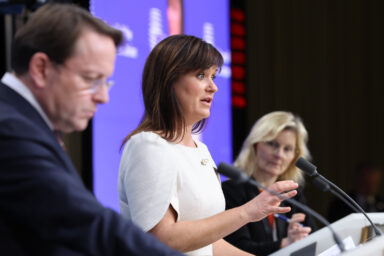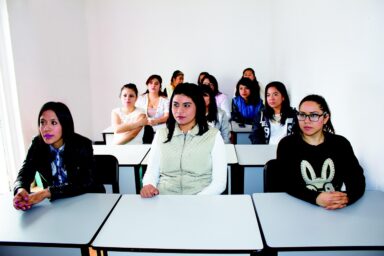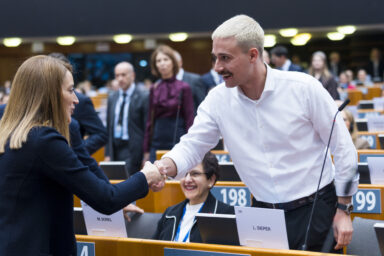The westward intra-EU drift of skilled health care workers may look like a solution for richer countries now, but is unsustainable in the long term, warns MEP András Kulja. The Hungarian Christian Democrat is rapporteur for the report on health workforce crisis. The European Parliament’s health and employment committees are to publish their first joint draft this week.
The health agenda of MEP András Kulja (EPP/HUN) doesn’t stop at the workforce file. He is also in the thick of negotiations on the pharmaceutical legislation revision and the Critical Medicines Act. And he has sounded the alarm on Europe’s vulnerability to climate-linked health threats and the growing burden of dementia in an ageing population.
Europe’s health debate is back to the basics: who will do the work? The Parliament’s draft report on the workforce crisis is due this week. Why is this such a big priority for you?
Healthcare is a deeply personal priority for me, not least because in Hungary it is our biggest challenge. We face a severe shortage of doctors and, above all, nurses. Too many of our talented professionals leave for other member states. This creates an internal brain drain that weakens care at home. To address this, we need European support for reward schemes, fair reimbursement, and clear career pathways that give professionals real incentives to stay.
You might be interested
Specialised training and continuous professional development are essential to keep our workforce motivated, skilled, and valued. At the same time, Europe must embrace digital transformation in a way that empowers, not overwhelms, professionals. With proper training, artificial intelligence can reduce administrative burdens, streamline diagnostics, and free up time for patient care. Used responsibly, AI can improve efficiency and the well-being of healthcare workers. A European workforce strategy that combines better incentives, specialised training, and smart use of technology will be crucial to retaining talent and ensuring resilient health systems for the future.
If workforce shortages are the most urgent crisis, another you’ve said is underestimated is climate-linked health threats. Why do you think Europe isn’t taking them seriously enough?
I believe the EU does not rank climate-linked health threats high enough on its political agenda. Many still wrongly assume that mosquito-borne diseases such as dengue, chikungunya, or West Nile virus only affect developing countries. But this is no longer true. Europe already saw over 700 locally acquired West Nile virus cases and 67 deaths in 2023, and the number of imported dengue cases has risen from 1,500 in 2022 to nearly 5,000 in 2023. Climate change is not just a distant threat, it is already reshaping health risks in several member states. Yet, compared to other crises, this remains under-prioritised.
Europe must embrace digital transformation in a way that empowers, not overwhelms, professionals. — MEP András Kulja (EPP/HUN)
Where are the biggest gaps in the EU’s preparedness for climate-related disease outbreaks?
The EU has taken important steps with the Preparedness Union Strategy, HERA, and ECDC networks such as VectorNet. But there are still some gaps. Member states still fail to coordinate surveillance and reporting, which delays early detection and response.We should consider better coordination of national responses to avoid fragmentation on the EU level.
We need a common EU framework for tackling climate-driven disease outbreaks. So that member states coordinate surveillance, reporting, and response across borders. Also, we lack stockpiles of vaccines and treatments for many mosquito-borne diseases. And national immunisation advisory groups (NITAGs) have been slow to issue recommendations.
Do you think existing EU health frameworks are sufficient to address climate-driven diseases?
Existing frameworks are not yet sufficient. While the EU Health Union and Preparedness Union strategies are steps forward, they need to explicitly prioritise climate-related health threats. HERA and ECDC should list mosquito-borne diseases among priority threats and dedicate resources accordingly.
Regulators must streamline processes so member states can safely deploy vaccines and countermeasures. Without delays caused by the lack of coordination. The EU should adopt a One Health approach, integrating human, animal, and environmental health into its preparedness planning. Finally, the EU must scale up research and funding to develop vaccines, vector control tools, and diagnostic methods fit for a warming Europe.
Heatwaves are now the deadliest climate-linked event in Europe. What should the EU do to prepare?
Heatwaves are a silent killer – last summer alone, they caused tens of thousands of premature deaths across Europe. The EU should treat heat-related risks as an integral part of its climate-health policy. That means embedding heat preparedness into the EU’s Climate Adaptation Plan, with mandatory national heat action plans, early warning systems, and cross-border coordination.
It is particularly important to protect vulnerable groups. This risk hits the elderly, children, and people with chronic conditions the hardest. Investing in resilient public infrastructure, cooling in hospitals, sustainable urban planning with more green spaces, and housing adapted to extreme heat, is also crucial. Finally, we must integrate heat into surveillance systems alongside infectious diseases. So that health impacts are tracked and policy is based on real-time data.
Older people are among the most vulnerable, not only to heatwaves and other climate-driven risks, but also to dementia. Why does Europe need a dementia strategy now?
We need to adopt a European Dementia Strategy to support early diagnosis, access to treatment, carer support, and ensure every member state develops an aligned national dementia plan. Dementia is not just a medical condition. It is a human, social, and economic challenge that reshapes the lives of millions of European families. As I shared in Plenary, my own grandmother’s journey with Alzheimer’s showed me how painful, exhausting, and isolating this illness can be not only for the person affected but also for those who love and care for them.
HERA and ECDC should list mosquito-borne diseases among priority threats and dedicate resources accordingly. — MEP András Kulja
That is why the EU must move from words to action. We need to close the gap between healthcare and social care. So families are not left to shoulder this burden alone. We need to adopt a European Dementia Strategy to support early diagnosis, access to treatment, carer support, and ensure every member state develops an aligned national dementia plan.
EU funding should support pilot projects that bring together hospitals, primary care, and community-based services. So that people with dementia receive continuous, coordinated care instead of being passed from one system to another. Families need structured support, not just compassion. Finally, we need to bridge shortages. By funding dementia-specific training for healthcare and social-care professionals. And by promoting task-sharing models that make systems more resilient. Europe must lead with ambition, because behind every statistic is a family that cannot wait.











